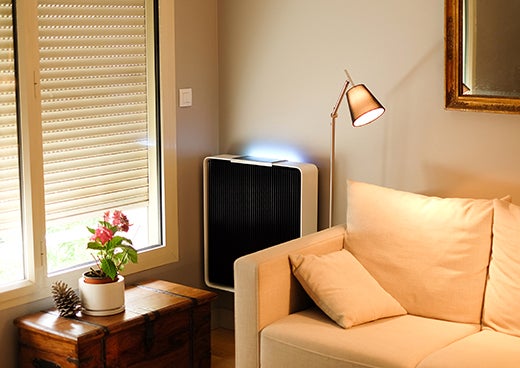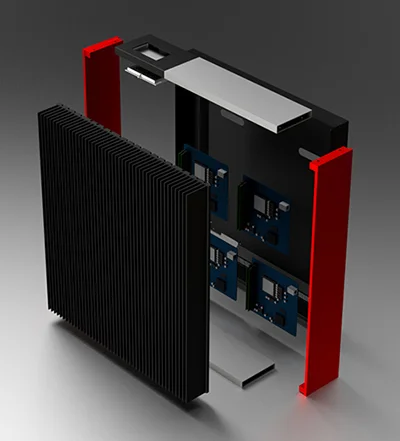[ad_1]
This year’s Blender Conference was filled with all kinds of interesting talks about interesting uses of Blender and open source technology. A particularly novel one that caught my eye was nestled neatly within the art and pipeline presentation for the Blender Institute’s open movie, Cosmos Laundromat. In that talk, Paul Benoît of Qarnot Computing spoke about his company’s very unique render farm.
 It’s common knowledge that high-performance computing (HPC) generates a lot of heat. At HPC datacenters, a lot of time and energy is spent figuring out how to cool these powerful computers. Not only does this have a significant environmental impact, Qarnot sees this as wasted energy (and wasted opportunity). As a solution, they’ve designed a “digital heater” that they call a Q.rad.
It’s common knowledge that high-performance computing (HPC) generates a lot of heat. At HPC datacenters, a lot of time and energy is spent figuring out how to cool these powerful computers. Not only does this have a significant environmental impact, Qarnot sees this as wasted energy (and wasted opportunity). As a solution, they’ve designed a “digital heater” that they call a Q.rad.
The device is really just a high-performance computing node sold as a space heater. The Q.rad provides computation power for HPC needs while also providing free heat where they’re installed. Even better, this is all made possible because of open source software like Linux, Docker, and (of course) Blender.
Get the details in this interview with Paul Benoît of Qarnot Computing.

Can you tell us how the Q.rad digital heater system works?
The Q.rad is the first heater to use embedded processors as a heat source. Totally silent, it gets computing instructions through the Internet and the heat produced by workload processing provides free and efficient heating for homes, public buildings, and offices.

Courtesy of Qarnot Computing. All Rights Reserved.
Along with the Q.rad, Qarnot developed Q.ware, the software platform that dynamically and securely distributes our clients’ computations on our Q.rad digital heater farm.
Fully automated, the Q.ware platform is in charge of computing node selection, payload boot sequence, data distribution and output results collection, processors frequencies adjustment, and job management.
In your presentation, you mentioned that there’s no storage on the heaters; that they were specific Docker images for whatever computing tasks you need (such as rendering frames for Cosmos Laundromat). In addition to Blender and Docker, how is open source helping make your products a reality?
Open source mainly allows us to adapt applications to our specific infrastructure (headless, diskless, etc.). Beyond licensing economical and technical issues, it’s often a pain to integrate commercial closed source applications. They are rarely designed to be versatile, and editors’ commercial priorities make it difficult to have custom features.
We also believe that most infrastructure-intensive software will end up with a really professional-grade open source player, as is the case for 3D rendering with Blender. It’s also in our common interest to take part in the development to make that software as versatile as possible. That’s why we took part in Blender’s Flamenco project.
Because there’s no storage on the Q.rad heaters, I’d imagine that the network connection to them would need to be pretty robust. Are they just using the customer’s broadband connection, or is there a separate connection that these devices use?
We either use customers’ fiber-to-the-home or a dedicated fiber-to-the-building depending on the site size. Within the building, we use a dedicated LAN.

Inside the Q.rad digital heater. Courtesy of Qarnot Computing. All Right Reserved.
So the Q.rad provides free heat from high-performance computation. Cosmos Laundromat was rendered in July, a pretty hot month of the year in the northern hemisphere. How did that work? Does the Q.rad work any differently during warm summer months?
We provide our client with a global throughput in terms of GHz, allowing us to involve more nodes with lower frequencies. In the case of Cosmos Laundromat, it was a requirement to have full-speed nodes. So we had to statically allocate some jobs to specific nodes we were able to use without bothering hosts, notably within a school closed in July.
What about security? The computing power in a Q.rad is pretty significant. Are there any measures in place to prevent people from taking apart their heaters so they can use those processors for other purposes? Is there any concern that someone could compromise a network of Q.rad heaters and use them for nefarious purposes?
Our infrastructure integrates encryption and authentication security modules to propose an end-to-end protection of our clients’ data. The stateless/diskless architecture is also a protection against data analysis. Concerning the hosts, we monitor the integrity of our heaters to discard mistrusted ones until our next maintenance visit. Of course, the heater can still compute non-sensitive jobs to generate heat.
 Blender is a free and open source 3D creation suite. The Blender Conference is an annual event held in Amsterdam for developers, designers, and enthusiasts to learn more about Blender techniques, features, and tools.
Blender is a free and open source 3D creation suite. The Blender Conference is an annual event held in Amsterdam for developers, designers, and enthusiasts to learn more about Blender techniques, features, and tools.
[ad_2]
Source link